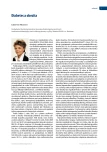GLP1-analogs – suitable choice in obese patients with type 2 diabetes mellitus
Authors:
Zbynek Schroner
Authors‘ workplace:
SchronerMED, s. r. o., interná a diabetologická ambulancia, Košice
Published in:
Forum Diab 2016; 5(1): 25-28
Category:
Topic
Overview
Therapy with GLP1-analogs shows various multiorgan benefits. Possible reasons of preference of this treatment are: efficacy, decrease of weight, safety (low risk of hypoglycemia, small incidence of serious adverse events), potential favourable cardiovascular effects (influence on blood pressure, lipids, markers of CV risk). In context of individual approach, therapy with GLP1-analogs is suitable choice in obese patients with type 2 diabetes mellitus
Key words:
type 2 diabetes mellitus – GLP1-analogs – therapeutic place
Sources
1. Inzuchi SE, Bergenstal RM, Buse JB et al. Management of Hyperglycemia in Type 2 Diabetes. A Patient-Centered Approach. Update to a Position Statement of the American Diabetes Association (ADA) and the European Association for the Study of Diabetes (EASD). Diabetes Care 2015; 38(1): 140–149.
2. Schroner Z, Uličiansky V. Liečba diabetes mellitus 2. typu založená na účinku inkretínov. 2. ed. SchronerMED: Košice 2011. ISBN 9788097071479.
3. Meier JJ. GLP-1 receptor agonists for individualized treatment of type 2 diabetes mellitus. Nat Rev Endocrinol 2012; 8(12): 728–742.
4. Horowitz M, Rayner CK, Jones KL. Mechanisms and clinical efficacy of lixisenatide for the management of type 2 diabetes. Adv Ther 2013; 30(2): 81–101.
5. Uličiansky V, Schroner Z, Némethová Z et al. Personalizovaná medicína v kontexte odporúčaní ADA/EASD 2015. Forum Diab 2015; 4(2): 102–118.
6. Schroner Z, Uličiansky V. Multiorgánové benefity GLP-1 analógov. Interná Med 2015;
7. Drucker DJ, Nauck MA. The incretin system: glucagon-like peptide-1 receptor agonists and dipeptidyl peptidase-4 inhibitors in type 2 diabetes. Lancet 2006; 368(9548): 1696–1705.
8. Nikolaidis LA, Elahi D, Hentosz T et al. Recombinant glucagon-like peptid 1 increases myokardial glucose uptake and improves left ventricular performance in conscious dogs with pacing -induced dilated cardiomyopathy. Circulation 2004; 110(8): 955–961.
9. Nikolaidis LA, Mankad S, Sokos GG et al. Effects of glucagon-like peptid-1 in patients with acute myocardial infarction and left ventricular dysfunction after successful reperfusion. Circulation 2004; 109(8): 962–965.
10. Martinka E. Nové smerovania v liečbe diabetes mellitus 2. typu ovplyvnením hladiny inkretínov – sitagliptín – účinnosť a bezpečnosť. Diabetes a obezita 2008; 15(8): 49–59.
11. Bose AK, Moicanu MM, Carr RD et al. Glucagone-like peptide 1 can directly protect the heart against ischemia/ reperfusion injury. Diabetes 2005; 54(1): 146–151.
12. Sokos G, Nikolaidis LA, Mankad S et al. Glucagon-like peptide 1 infusion improves left ventricular ejection fraction and functional status in patients with chronic heart failure. J Card Fail 2006; 12(9): 694–699.
13. Gallwitz B. Extra-pancreatic effects of incretin–based therapies. Endocrine 2014; 47(2): 360–371.
14. Kretzschmar Y, Gourdy P, Penfornis A et al (OTBC). Effectiveness and tolerability with liraglutide among patients with type 2 diabetes. 1-year data from EVIDENCE: A 2-year prospective, follow-up, post-marketing study. Diabetologia 2013; 56: S369.
15. DeFronzo RA, Eldor R, Abdul-Ghani M. Pathophysiological approach to therapy in patients with newly diagnosed type 2 diabetes. Diabetes Care 2013; 36(Suppl 2): S127-S139.
16. Kapitza CH, Bode B, Ingwersen SH et al. Preserved pharmacokinetic exposure and distinct glycemic effects of insulin degludec and liraglutide in IDegLira, a fixed-ratio combination therapy. J Clin Pharmacol 2015; 55(12): 1369–1377.
17. Schroner Z. Súčasnosť a perspektívy inzulínovej liečby. Interná Med 2014; 14(4): 159–163.
Labels
Diabetology Endocrinology Internal medicineArticle was published in
Forum Diabetologicum

2016 Issue 1
Most read in this issue
- New drugs in the treatment of obesity: their availability for clinical practice
- GLP1-analogs – suitable choice in obese patients with type 2 diabetes mellitus
- Metabolic changes after bariatric/metabolic operations
- Nonalcoholic fatty liver disease – a serious comorbidity of diabesis
